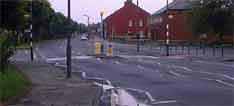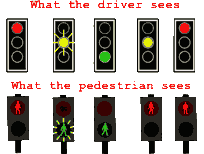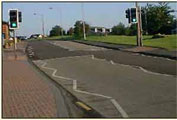 Pedestrian Crossings
Pedestrian Crossings 
Pedestrian Crossings
You will encounter several types of crossing whilst driving - we discuss the main ones in this tutorial and look briefly at some others.
You will find that there are rules applying to be adhered to when you encounter pedestrian crossings and we will look at those as well as examining how to deal with the crossings safely.
Pedestrian crossings are hazards and we always use the MSM routine to enable us to plan for and deal with any hazard.
Let's look at how we will be dealing with zebra crossings
[Next]
Zebra Crossings
When driving we should be looking well ahead to identify any hazards and then applying the MSM routine to deal with them safely.
On the approach to zebra crossings you should assume that there are people using the crossing if you cannot see that both sides of the crossing are clear - you should always approach a crossing at a speed at which you can stop safely if necessary.
 Some crossings may give advance warning by use of a sign but you can recognise a zebra crossing as you approach it by the distinctive flashing belisha beacons on each side of the crossing and sometimes in the centre of the road.
Some crossings may give advance warning by use of a sign but you can recognise a zebra crossing as you approach it by the distinctive flashing belisha beacons on each side of the crossing and sometimes in the centre of the road.
Prior to the crossing the road is marked by zig zag lines leading to give way markings on the road just before the black and white striped crossing area.
Mirrors - having identified that we are approaching a crossing then we must check in our mirrors to confirm the traffic situation behind us.
Signal - then knowing what lies ahead and to the rear we wil be in a position to decide on whether a signal will be necessary - if you are going to slow down for the approach then the brake lights will inform following drivers, but an arm signal should be considered to inform pedestrians and drivers approaching from the opposite direction who will not be able to see your brake lights.
Manoeuvre - the manoeuvre in this case would be slowing down or coming to a stop if necessary. You must approach the crossing at a speed that will allow you to stop safely before the give way line - but you should not approach excessively slowly if it is obvious that there isno one about to use the crossing.
Right of way - we must always remember to give way to any pedestrians who have set foot on the crossing.
There are some rules relating the zebra crossing that we need to know.
When & Where to Stop
If there were elderly people or mothers with prams at the side of the road clearly intending o use the crossing you should consider giving way and allowing them to use the crossing. Be alert also for groups of pedestrians stood near the crossing any of whom could step out at any time. When you do stop it must be before the give way line just before the marked crossing area.
Don't Creep or Wave People Across
If you have stopped to allow a pedestrian to cross and they appear hesitant and undecided - give them time to make up their minds, do not beckon them or try to make up their minds for them, nor should you begin to creep forward before the crossing is clear.
Overtaking,Stopping & Parking
When you enter the zig zag area you must not overtake the leading moving vehicle on the approach to the crossing or the leading vehicle that has stopped at the crossing to allow pedestrians to cross.
If you are in a queue of traffic at a crossing you should always leave the crossing area clear for pedestrian use.
You must never park within the area marked by the zig zag lines on a crossing - a vehicle parked in this area would restrict the view of other drivers and any pedestrians intending to use the crossing. Because of the danger it is an offence to park in this area.
If the Crossing is in 2 halves
When you have stopped at a zebra crossing you should wait until any pedestrians have cleared the crossing, however if the crossing has a central island then it forms 2 separate crossings and you can move off when it is safe to do so - when pedestrians are on the other half of the road, but you must watch for pedestrians who may cross from your right and walk straight into the crossing.
Pelican Crossings
Pelican crossings (Pedestrian Light Controlled Crossings) are controlled by traffic lights which are activated by pedestrians pressing a button on the box on the traffic light pole at the side of the road.
 They can be identified by the traffic lights on approach and the zig zag lines before and after the crossing - note that there is stop line rather than a give way line immediately prior to the crossing and the crossing area is marked by a row of studs across the road rather than black and white stripes.
They can be identified by the traffic lights on approach and the zig zag lines before and after the crossing - note that there is stop line rather than a give way line immediately prior to the crossing and the crossing area is marked by a row of studs across the road rather than black and white stripes.
 The light sequence of the traffic lights is a little different to the normal type of traffic lights that we meet, after green they change to amber and then red with the normal meanings for those lights, after red however it changes to a flashing amber light which means that you may proceed if the crossing is clear of pedestrians and if it is safe to carry on. Obviously you must keep a look out for pedestrians who may try to dash across when the amber light is flashing, after the flashing amber phase the lights change back to green.
The light sequence of the traffic lights is a little different to the normal type of traffic lights that we meet, after green they change to amber and then red with the normal meanings for those lights, after red however it changes to a flashing amber light which means that you may proceed if the crossing is clear of pedestrians and if it is safe to carry on. Obviously you must keep a look out for pedestrians who may try to dash across when the amber light is flashing, after the flashing amber phase the lights change back to green.
MSM - we apply the MSM routine on approach as usual - if the light is showing red then we would make a normal stop - if the light is showing green then we must approach with caution and adjust our speed to be able to stop safely if required.
If there are pedestrians waiting at the crossing the lights may change very quickly. Even if there is no one about be prepared for the lights to change (children sometimes press the button to activate the signals and then move away).
 Unlike the zebra crossing a straight pelican crossing with a central island is still one crossing and you should wait if pedestrians are crossing from the right even if the amber light is flashing.
Unlike the zebra crossing a straight pelican crossing with a central island is still one crossing and you should wait if pedestrians are crossing from the right even if the amber light is flashing.
A staggered pelican crossing however, will have 2 sets of lights (one for each side of the carriageway) and each side will be a separate crossing.
Next we'll look at a couple of Crossings that are often misunderstood by drivers
Puffin Crossings
Puffin Crossings have electronic devices which detect when a pedestrian is on the crossing and delays the green light until the pedestrians have reached a safe place.
You will often encounter them on main roads where traffic moves quite quickly - if you see a set of traffic lights but there is no sign of a junction on a road where the traffic is fast flowing then it may well be a Puffin Crossing.
The light sequence is the same as for normal traffic lights and is initiated by the pedestrian pushing a button on the traffic light pole.
Toucan Crossings
Are also push button controlled, have no flashing amber phase and can be used by both pedestrians and cyclists.